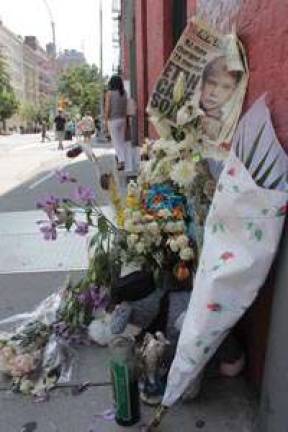Etan Patz Case Solved?

After a NJ man is formally charged with '79 murder of Soho boy, residents reflect on how ?a disappearance changed a neighborhood It was a fateful day on May 25, 1979, when 6-year old Etan Patz attempted a first-time walk on his own to his school bus stop at the corner of Prince Street and West Broadway. It would be the last time anyone would ever see the boy again. But now, 33 years later, amid headlines from across the city and the nation, NYPD officials have expressed confidence that a New Jersey man, a former Soho bodega stock boy, is the person who abducted the 6-year-old on his way to school. He has now been officially charged with second-degree murder in the decades-old case, Pedro Hernandez, 51, of Maple Shade, N.J., confessed to NYPD detectives last week that he abducted, strangled and discarded Patz's body in the trash near a bodega at 448 West Broadway, where Hernandez had worked and Patz had stopped to buy a soda on his way to school. Hernandez reportedly told police he had never seen the boy before and had decided to abduct him because of an "urge to kill," according to a law enforcement source quoted in the New York Post. Despite a lack of any physical evidence and little hope of recovering Patz's body, Police Commissioner Ray Kelly told the press last Thursday, "We believe this is the individual responsible for the crime." A lawyer for Hernandez has said that he suffers from mental illness, including delusions and hallucinations. Hernandez was identified as a suspect in the past month by a member of his family, reported to be his brother-in-law, Jose Lopez, following the news that NYPD and FBI investigators had been digging up a basement on Prince Street where yet another suspect, handyman Othniel Miller, had kept a woodshop. That search did not yield any evidence. Before last month's renewed interest in the case, police officials believed a convicted and incarcerated pedophile named Jose Ramos was responsible for killing Patz. Ramos had known one of Patz's former babysitters, and circumstantial evidence against Ramos was strong enough that in a 2004 case, he was held civilly liable for the boy's death. Ramos has continued to deny any involvement in Patz's disappearance. From both a local and national perspective, however, the impact of the Patz case has been undeniable. "Today?law enforcement is responding more swiftly and effectively than ever before: We have mobilized the eyes and ears of the public to help in the search for missing children through the use of technology and new tools like the Amber Alert; parents are more alert and aware; and the result is that more missing children come home safely today than at any time in American history," said Ernie Allen, president and CEO of the National Center for Missing and Exploited Children. In addition, Allen said, an important change came about in 1982, when Congress passed the Missing Children's Act, making it possible to enter information about missing children into the FBI's National Crime Computer. He added that the renewed investigation into the Patz case has helped shine the spotlight back on missing children. "We have seen a huge increase in interest and calls-but I think the most positive and important result is that we are hearing from many parents of long-term missing children. It has given them hope?When NYPD and the FBI started digging up that basement last month and then made an arrest this week, it sent a loud, clear message to searching parents and to law enforcement everywhere that these cases are never closed until we either find the child or learn with certainty what happened to the child," Allen said. Janet Hayes, a local political leader and longtime village resident who was living on the Upper East Side at the time of Patz's disappearance, recalled that everyone in the city was aware of the case. "It was an event that did affect the whole city, no matter where you lived," Hayes said. "We read about crimes all the time, but a 6-year-old boy abducted on his way to school from a safe neighborhood was not supposed to happen. I still remember his face on the milk carton. People talked about it for a long time." Sean Sweeney, director of the SoHo Alliance and a neighborhood resident for more than 30 years, recalled the neighborhood back then as being much more quiet, with almost no tourists. "The area was very quiet; you only had factory workers in the area. Kids were definitely able to walk to school and be safe," Sweeney said. He said he too remembered the posters of Patz that dotted the neighborhood after his disappearance, and recalled police knocking on his door about a week after Memorial Day. "They knocked on my door and I was busy-I couldn't talk to them," he recalled. "They didn't make it sound urgent, it seemed routine to me." But with the recent confession and arrest of Hernandez, Sweeney expressed surprise. "I was shocked when I heard the reports," he said. "I remember that bodega where he worked. It always seemed very dark and dirty, like there was something not right there."